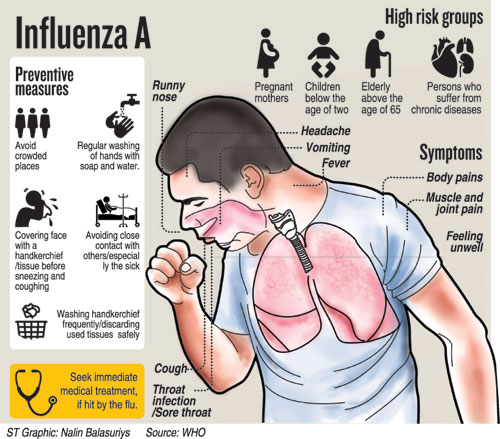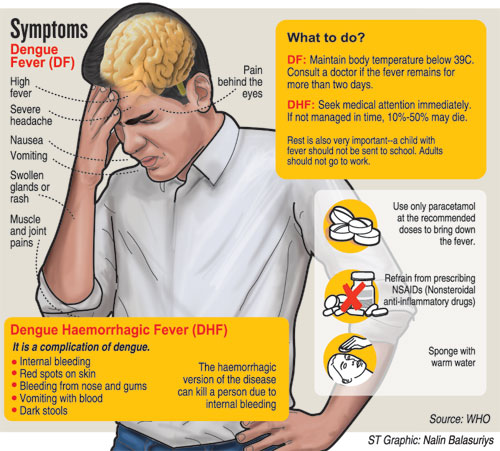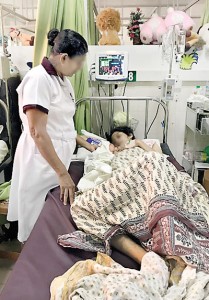News
Sniffles, coughing, sneezing and body-aches herald the season
 It is a virulently-ill nation that will brace itself to welcome the dawn of the National New Year, not with joy and laughter but with sniffles, coughing, sneezing and body-aches.
It is a virulently-ill nation that will brace itself to welcome the dawn of the National New Year, not with joy and laughter but with sniffles, coughing, sneezing and body-aches.
In a rampage by the twin viral fevers of dengue and Influenza A including H1N1, both state and private hospitals are overflowing and many fear that they would be laid low in wards and not home to enjoy the Avurudu.
In the first three months of this year, 25,000 people have been hit by dengue, compared to 12,800 last year. At the end of March, 53 people have died of dengue. This is while the Peradeniya University has shut down due to a large number of its hostellers coming down with the flu.
The Sunday Times turns to an expert on these infectious diseases, former Chief Epidemiologist, Dr. Nihal Abeysinghe, for some guidance on the epidemics sweeping the country.
Pointing out that Sri Lanka has strong curative and preventive sectors in the state health sphere, he stresses that the need of the hour is for both groups to work hand-in-hand to overcome dengue and Influenza A.
‚ÄúThere should be heavy and constant coordination among all segments carrying out disease surveillance, laboratory services, implementation of decisions at both regional and provincial levels and also implementation of public awareness campaigns,‚ÄĚ says Dr. Abeysinghe, adding that dengue is an environmental health issue.
Coordination is the key, he underscores, also reiterating that eyes and ears should be given to the technical experts, while strong and firm targets need to be set, not just during an epidemic but throughout the year, while ensuring that the targets are scrupulously met.
During an epidemic, regular meetings to check whether targets are being met should be held not every month but every week, he urges, adding that such meetings, at least once a month should be continued throughout the year, even during non-disease spells.
Recalling how he reacted from 2004 to 2008 after dengue had taken a strong toll before, Dr. Abeysinghe says that the Epidemiology Unit identified all Medical Officer of Health (MOH) areas hit by dengue and along with the regional epidemiologists visited each area and conducted a thorough technical review at both national and district levels.
‚ÄúWe looked closely at what was going on and what duties needed to be carried out by which officials at different levels. Next came the reviews whether such duties had been performed and in the old fashioned way the deficiencies and non-performance were examined,‚ÄĚ he says adding that it has to happen essentially and mandatorily at all MOH and district levels. These should be technical meetings to identify deficiencies and redress them and not headed by politicians.¬†¬†
Dr. Abeysinghe also pointed out that public attitude seems to have changed to ‚Äúno care‚ÄĚ complacency. He cited the example of men, women and children going about their usual routine without taking simple precautions such as not being in crowded places unless essential.
It is still not too late, he says, adding that learning from the current health crisis we need to plan and plan ahead how to keep diseases such as dengue and influenza at bay.
A visit to the National Institute of Infectious Diseases at Angoda accompanying a patient, meanwhile, gives the Sunday Times a clear picture of the heavy burden the state hospitals are facing. The institute has treated 60% of the total number of dengue patients from the Colombo district.
Several doctors with face masks are efficiently checking out a large number of people in long and straggly queues, while minor staff helped by members of the Civil Defence Force is wheeling those who have been admitted to their respective wards. The lines at the dispensary counters issuing the medications are equally long, indicating that the state system is creaking and groaning under a huge load. The wards too are filled to overflowing and the nurses are rushing about attending to a large number of patients.
Not only are there two patients to a bed in the wards accommodating dengue cases but also on the beds in the corridors, the Sunday Times sees, while the feedback from numerous hospitals across the country is the same.
A chart on the wall of Consultant Physician Dr. Ananda Wijewickrama at the National Institute of Infectious Diseases is an eye-opener about what is happening with regard to dengue and the chilling message of what to expect in the near future.
‚ÄúUsually, we don‚Äôt have many dengue cases in the first three months of the year,‚ÄĚ explains Dr. Wijewickrama, pointing out that this year though there has been a sharp spike.
He lifts a danger flag very high when he says that the dengue peak normally is in June and Sri Lanka would be in serious trouble if that trend continues this year.
‚ÄúThe hospitals are stretched to capacity and we need to do something to prevent another epidemic. Otherwise the consequences would be disastrous,‚ÄĚ he points out, requesting that in the next allocation of staff such as nurses and medical officers, those at state hospitals dealing with dengue etc which is now endemic should be given more numbers.
‚ÄúWhen will we ever learn,‚ÄĚ is the question being asked by many including health officials, specifically with regard to dengue.
The oft-repeated complaint is that dengue is not just the business of the health sector but of all and not just when the rains begin but throughout the year. Here are some measures to keep dengue at bay:
*The local government bodies should clear the garbage, turn the searchlight on mosquito breeding and harbouring spots not only in homes and commercial areas but also at construction sites and respond rapidly when dengue cases are notified to stop the disease from spreading
* The people themselves should check their homes and surroundings with a sharp eye every few days to search out and then destroy all mosquito breeding and harbouring spots.
* All large institutions such as schools, tuition classes, marketplaces, construction sites should have a dedicated person to go around daily to find mosquito breeding and harbouring spots and destroy them.
A hard fought battle saves young mother  Mother who went into labour in the midst of fluid leakage of Dengue Haemorrhagic Fever will be going home soon with her newborn The most recent poignant life-and-death drama was played out at the Centre for the Clinical Management of Dengue and Dengue Haemorrhagic Fever in Negombo, with all medical teams working in tandem to save a young mother who delivered her baby while in the vice-like grip of Dengue Haemorrhagic Fever (DHF) and fluid leakage. ‚ÄúThe mother‚Äôs platelet count was only 20,000 when she went into labour. Soon after the delivery of the baby, her haemoglobin dropped and there was post-partum haemorrhage which ensued in a battle to save her life by providing platelets and blood transfusions and medication. Both mother and baby are doing fine now and will be discharged soon,‚ÄĚ says Consultant Paediatrician Dr. LakKumar Fernando, highly commending his colleagues — the Physician and the Obstetrician & Gynaecologist and their teams who worked with the dengue team diligently. The delivery was in the centre and not in the labour room as there was no time to take her there, says Dr. Fernando who set up the centre to treat both adults and children, heaving a sigh of relief at the mother‚Äôs recovery from a close brush with death. The Negombo Centre too is bursting at its seams with patients, with even the other paediatric and medical wards having two patients to a bed. The Negombo Centre needs more staff as well, as they are stretched to their limits, it is learnt. Dr. Fernando, who is performing volunteer work at Negombo, meanwhile, has set up a tiny replica of the Negombo Centre at the Kinniya Hospital to meet a humanitarian crisis there, but is hard put to find volunteer doctors to do a short stint in this eastern hospital. ‚ÄúPlease help out,‚ÄĚ is his urgent plea. |
| Flu- like symptoms? Vulnerable groups should take extra precautions Influenza A including H1N1 is a mild respiratory disease, reiterates Consultant Epidemiologist Dr. Samitha Ginige of the Epidemiology Unit, underscoring that vulnerable people, however, need to seek early treatment. It is not Avian Flu (Bird Flu), it is not Swine Flu and it is not a novel or unusual virus, he is quick to point out, explaining that even globally influenza activity has increased and in this region, India and the Maldives are facing a similar situation as Sri Lanka. Normally, H1N1 causes mild flu-like symptoms which can be overcome by resting, not going to work, school or tuition, taking lots of warm liquids and paracetamol if there is fever, says Dr. Ginige, however cautioning ‚Äėvulnerable‚Äô groups to take extra precautions immediately. These groups are the very young, below two years of age; the elderly, over 65 years of age; expectant mothers; those with chronic conditions such as diabetes, chronic respiratory illnesses such as asthma and cardiac, renal or liver disease, cancer and those who are immuno-compromised such as after chemotherapy, radiotherapy or organ transplants. ‚ÄúSuch people, if affected by the flu, need to seek treatment from a qualified doctor immediately to prevent complications which could result in pneumonia,‚ÄĚ he says, explaining that the anti-viral medication, tamiflu, is available in hospitals and would be administered to in-ward patients on the instructions of a Physician. This is to prevent misuse and over-use which would result in people developing resistance to this drug. Simple measures could prevent the spread of Influenza A, says Dr. Ginige, stressing the following: Regular hand-washing is a simple but effective means of stopping the transmission of the virus from person to another, as it is when a person touches an infected item and touches the mouth, nose or eyes that the disease most commonly spreads. Avoid crowded places as much as possible. As the disease is spread by infected droplets when an ill-person sneezes or coughs, any person who is ill should use a tissue ideally and immediately discard it into a bin without keeping it lying around. The best way to prevent the spread is for an infected person to sneeze or cough into the crook of his/her elbow and also keep washing the hands. Looking at virus types which cause influenza, Dr. Ginige tells the Sunday Times that they are A, B and C, but the third is not circulating among humans, only animals. While in 2016, the predominant virus was Influenza B, this year it is Influenza A including H1N1. There is some residual fear about H1N1, according to him, because it started off in Mexico in 2009 as a new virus, not identified before, setting off a pandemic alarm. It was then called the Swine Flu but there has been a name-change now. Since then it has been downgraded to the usual flu. Reassuring the public, Dr. Ginige says that the Epidemiology Unit with the Medical Research Institute monitors 20 sentinel sites at different hospitals by collecting 10 samples from each site and testing them. This is to study virus patterns. Usually, influenzas peak between November and February and once again in May, June and July. This year, it came ‚Äúa little bit late‚ÄĚ setting off illness in January. When asked why, he said that it could be due to climate change, while pointing out that it seems to be waning now with the numbers reducing slightly. To a query about the numbers, he points out that it would be difficult to say because it is not a notifiable disease. The deaths usually are due to the complications of pneumonia but a figure cannot be given as pneumonias could also be caused by organisms other than H1N1. They are in the process of analysing the figures. |

